
Through an Executive Summary of the U.S. Fire Administrator’s report, released this week, the U.S. Fire Administration (USFA) has put out both a warning of the dangers posed by growing wildfire issues and a series of recommendations and strategies for fighting back.
The USFA is a component of FEMA, and in that role, guides federal efforts at fire data collection, related education, and research, as well as providing training for firefighters. In its report, the agency recommended five efforts to form the basis of a Fire Service National Strategy:
- Preparing firefighters for climate-driven increases in wildfires with proper training and equipment
- Countering a firefighter shortage with a national apprenticeship program
- A cancer screening strategy for firefighters that invests in research and reduces or eliminates exposure to dangerous cancer- and other health problem-causing contaminates such as PFAS
- Behavioral health resources and suicide prevention initiatives for firefighters
- Creating and enforcing new codes and standards on affordable and fire-safe housing to create safer communities overall
“Now, more than ever, we have the means to address the fire-related challenges we face, including wildfire due to climate change, improvements in codes and standards to protect our most vulnerable citizens, developing recruitment programs for a diverse and well-trained American fire service and the reduction of cancer-causing chemicals affecting firefighters, as well as supporting the mental health of our first responders,” U.S. Fire Administrator Dr. Lori Moore-Merrell said. “Innovative thinking, the willingness to use all available tools, and, perhaps most importantly, the collaboration of all parties is necessary to meet these challenges.”
She added that fires are one of those matters that truly highlight an equity issue in the United States – and an issue technology has failed to solve. Moore-Merrell noted that the chances of dying in a fire today are higher than 40 years ago and that fire-related deaths, injuries, and displacement tend to hit lower-income communities and people of color more than others.
For this and more, she and her agency envision this new report as the beginning of a comprehensive means of changing the scene.




